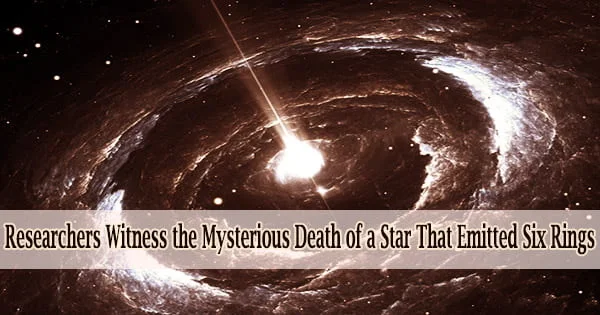The strange death throes of the red giant star V Hydrae, also known as V Hya, have been observed by astronomers who have been examining it in unprecedented detail.
The carbon-rich star has ejected six slowly expanding molecular rings and an hourglass-shaped structure that is ejecting material out into space at high speeds, according to researchers from UCLA and NASA’s Jet Propulsion Laboratory. This indicates that the star is undergoing rapid evolution as it ends its life in a blaze of glory before shutting down its energy production.
“This is the first and only time that a series of expanding rings has been seen around a star that is in its death throes a series of expanding ‘smoke rings’ that we have calculated are being blown every few hundred years,” said Mark Morris, a UCLA professor of physics and astronomy and a co-author of the study.
The results of the study, which included data from the Hubble Space Telescope and the Atacama Large Millimeter/submillimeter Array, or ALMA, were released on March 28 in the Astrophysical Journal.
Asymptotic giant branch stars, or AGB stars of which V Hya is an example evolve into more than 90% of stars with masses equal to or higher than those of the sun. The star sits in the constellation Hydra, 1,300 light-years away from Earth.
Astronomers have been particularly interested in V Hya among these millions of stars because of its distinctive characteristics and behaviors, such as its extremely large plasma eruptions that take place roughly every eight years and the existence of a nearly invisible companion star that contributes to V Hya’s explosive behavior.
“We have caught this dying star in the process of shedding its atmosphere ultimately most of its mass which is something that most late-stage red giant stars do,” Morris said. “But much to our surprise, we have found that the matter in this case is being expelled as a series of rings.”
We suspect that it might be related to the presence of orbiting companion stars, but it is difficult to explain that given the few-hundred-year interval between ring ejections. This star is providing a new and fascinating wrinkle to our understanding of how stars end their lives.
Professor Mark Morris
According to Morris, the crew saw high-speed gas bursts traveling in opposite directions that were perpendicular to the rings. He continued by saying that more research would be needed to determine the process behind the production of the rings.
“We suspect that it might be related to the presence of orbiting companion stars, but it is difficult to explain that given the few-hundred-year interval between ring ejections,” Morris said. “This star is providing a new and fascinating wrinkle to our understanding of how stars end their lives.”
The study’s primary author, JPL astronomer Raghvendra Sahai, said the findings suggest that past theories regarding star deaths might be inaccurate.
“Our study dramatically reveals that the traditional model of how AGB stars die through the mass ejection of fuel via a slow, relatively steady, spherical wind over 100,000 years or more is at best, incomplete, or at worst, incorrect,” he said.
According to the researchers, a distorted, disk-like structure was generated by the six rings that have extended from V Hya over a period of about 2,100 years, producing a dust-rich zone around the star. The structure was given the moniker “DUDE,” which stands for Disk Undergoing Dynamical Expansion.
“V Hya is in the brief but critical transition phase that dying stars go through at the end of their lives,” Sahai said. “It’s the phase when they lose most of their mass. It’s likely that this phase does not last very long, so it is difficult to catch them in the act. We got lucky with V Hya, and were able to image all of the different activities going on in and around this star to better understand how dying stars lose mass at the end of their lives.”
Another result of V Hya’s final act is an hourglass-shaped structure that is perpendicular to the disk and is centered on the star. A focused, swift wind, moving at two opposed directions at speeds of up to 500,000 miles per hour, has formed the hourglass’s two lobes.
Studying V Hya required a special device with the ability to clearly observe cold stuff that is impossible to detect with optical telescopes due to the vast amounts of dust surrounding the star.
Due to ALMA’s receivers’ extraordinary sensitivity to very brief radio wavelengths of about 1 millimeter, the star’s many rings and molecular gas outflows were clearly visible.
To create a magnificent image of a spectacular display in our galaxy, the researchers employed additional infrared, optical, and ultraviolet data, much of which was unexpected, according to Morris.
“Each time we observe V Hya, it becomes more and more like a circus, with each new evolutionary stage characterized by an even bigger variety of impressive feats,” Sahai said. “V Hydrae has impressed us with its multiple rings and acts, and because our own sun may one day experience a similar fate, it has us at rapt attention.”
The research was funded in part by the National Science Foundation and NASA.





